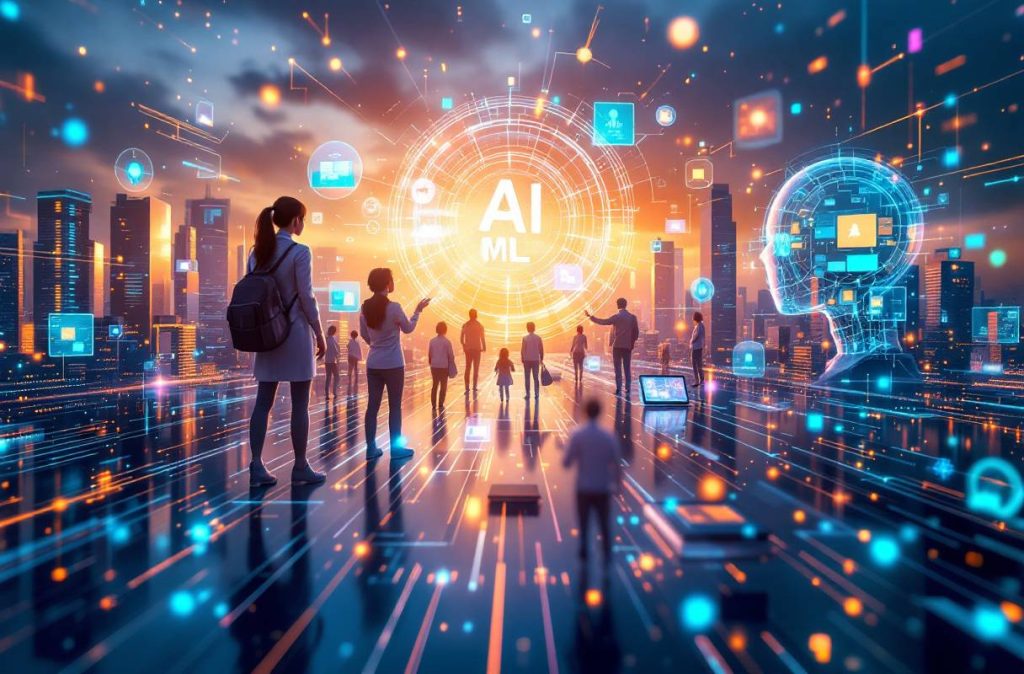Imagine a world where machines not only follow commands but also learn, adapt, and make decisions on their own. Welcome to the dynamic realm of Deep Learning vs. Machine Learning, where artificial intelligence is revolutionizing industries from healthcare to entertainment.
Whether you’re a tech enthusiast or a business leader, understanding the nuances between these powerhouse technologies can unlock unprecedented opportunities and drive innovation.
Let’s dive deep into how these intelligent systems are shaping our future and why distinguishing between them is more crucial than ever.
Overview of Artificial Intelligence and Machine Learning
The Booming Field of AI and ML
Artificial Intelligence (AI) and Machine Learning (ML) are shaking things up across different sectors. Whether it’s healthcare finance or even your favorite streaming platform, these technologies are making life a bit easier and way more interesting.
Picture AI as the super-clever assistant that spots patterns and ML as the brainy student learning from data. Businesses are kissing goodbye to mundane tasks as they start using AI for everything from chatbots answering customer queries ai chatbots for customer service, to apps that really get how customers feel natural language processing applications.
And hey, it’s not just the big players in the game. Even the scrappiest startups are jumping on this bandwagon. With AI in their toolkit, they personalize marketing AI marketing tools, make sense of the mountains of data collect big data and AI, and even come up with snazzy product ideas faster.
| Industry | Example Applications | Impact |
|---|---|---|
| Healthcare | Diagnostic tools, personalized medicine | Feels like magic in patient care and efficiency |
| Finance | Fraud detection, robo-advisors | Safer transactions and smarter investments |
| Education | Personalized learning platforms | Better attention grab and knowledge gains |
| Retail | Inventory management, customer insights | Smooth operations and happier shoppers |
Importance of Understanding Deep Learning vs. Machine Learning
Deep learning and machine learning are like siblings in the AI family, and knowing the difference is a big deal. Machine learning is the straight-A student, crafting algorithms that teach computers to learn from data. Its usage spans from sorting your spam email to predicting what pet video you’ll love next with machine learning basics.
Deep learning, on the other hand, dives deep into datasets like a puzzle lover tackling a thousand-piece jigsaw. Known for its complex neural networks, deep learning is the wizard behind image recognition, language processors, and voice assistants. Leaders noodling over whether to go for machine learning or deep learning have to know their stuff—like, if you’re into building self-driving cars or digging deep into medical scans, deep learning’s your pal neural networks explained.
| Aspect | Machine Learning | Deep Learning |
|---|---|---|
| Data Dependency | Happy with a smaller plate | The more data, the merrier |
| Execution Time | Quick on its feet | Works hard and takes its time |
| Hardware Needs | A regular computer buddy | Needs those high-tech graphics cards or chips |
| Complexity | Straightforward and fixable problems | Super complex, solving it can be tricky |
AI and ML aren’t just about flashy headlines; they bring real change and innovation to the business world. But jumping in without the right knowledge is like running a marathon without practicing. Get clued up about both techs to unlock their full potential. To delve into the nuts and bolts of machine learning, check our guide on machine learning algorithms overview. And if neural networks tickle your fancy, hop over to neural networks explained.
Defining Machine Learning
Machine Learning (ML) is a cool branch of artificial intelligence (AI), and it’s like a brain for computers, teaching them tricks without humans needing to code every step. It’s all about using fancy algorithms and number-crunching models to sniff out patterns and clues from data.
Concept of Machine Learning
Imagine it like a curious child who learns by seeing and doing. The aim? To create algorithms that take some input, fiddle with it, and guess the output through clever math magic. It lets machines make calls or foresee outcomes when new info pops up.
Machine learning comes in three flavors:
- Supervised Learning: Like a teacher showing examples, the system munches on labeled data, getting both the questions and answers. It then uses this schooling to guess answers for new, mystery data.
- Unsupervised Learning: Here, it’s all about freestyle. The system gets input with no labels, sifting through the chaos to find hidden gems and group them in its own quirky way.
- Reinforcement Learning: Think of it as trial and error in the wild. The system interacts with its setting, earning pats on the back or pats on its… circuits, refining its skills over time.
For more digestible 101s on machine learning, dip into our post on machine learning basics.
Applications and Use Cases
Machine learning isn’t just smart, it’s versatile too. Its knack for gobbling up and analyzing huge data piles makes it a powerhouse for cracking tough nuts. Here are some snazzy examples where ML is the unsung hero:
- Healthcare: Word on the street is ML’s diagnosing diseases, foreseeing patient results, and making treatment plans personal and snazzy. Wanna know more? Check out our piece on AI in healthcare.
- Finance: It’s like having a watchdog for fraud, a wizard for trading, and a psychic for credit risks, all wrapped in machine learning algorithms. Dive into AI applications in finance for a peek.
- Natural Language Processing (NLP): These techies are grooming chatbots, mood analyzers, and voice assistants. Dig into natural language processing applications for all the gory details.
Marketing: ML dishes out deep insights into shopper habits, jazzes up marketing campaigns, and segments customers smartly. AI marketing tools can be your guide.
- Education: Personalized learning swoops in with ML, tailoring lessons to learner quirks and upping those grades. Want intel? See AI applications in education.
- Customer Service: AI chatbots, smartened by ML, make customer support more chill and scale easily. Peek into AI chatbots for customer service for more.
Here’s a cheat sheet on types of ML and what they’re ace at:
| Type of ML | What It Does | Sample Use Cases |
|---|---|---|
| Supervised | Learns with examples, knows answers | Spotting fraud, Zapping spam |
| Unsupervised | Finds patterns like a detective | Divvying up customer groups, Uncovering odd behaviors |
| Reinforcement | Maestro in trying and learning | Self-driving rides, Video game smarts |
Machine learning doesn’t just help industries; it’s flipping them with its savvy decisions. If you’re itching for more, explore top machine learning courses to get your feet wet. Merging ML with big data and AI can open a world of mighty use cases.
Getting the hang of machine learning is key if you plan to tap into AI for business wizardry, tech leaps, or education innovations.
Peeking into Deep Learning
What’s This Deep Learning Buzz About?
Think of deep learning as the geeky cousin of machine learning that’s obsessed with layers. It’s like a brainiac brain, with neural networks stacked up like a layer cake, munching through data faster than a hotdog in a contest. As it gobbles more data, it gets smarter – spotting trends and patterns humans might miss while scrolling aimlessly through social media.
Unlike regular machine learning that nags you to manually pick out what’s important from the data, deep learning’s like, “Relax, I’ve got this.” Do you want the basics of machine learning? Swing by our piece on machine learning basics.
Complications and Cool Uses
Yeah, deep learning can be a bit of a data hog. It demands lots of computing power and hefty datasets. Why? Well, it has to do with layers upon layers of neurons playing a kind of telephone game with your data, each one digging out a little bit more meaning than the last.
Here’s how deep learning is shaking things up:
- Healthcare: Picture this – it’s like your doctor, minus the weird handwriting! Deep learning’s got the knack for spotting oddities in X-rays and MRIs, nailing down potential health issues before they’ve even stretched their legs. For more juicy details on AI in healthcare, check out our article on AI in healthcare.
- Finance: It’s the watchdog of the financial world. Deep learning tools sniff out fraud, figure out risks, and even second-guess the stock market. They fish through old data, connecting the dots to ward off scams faster than you can say “Ponzi scheme.” Want to avoid financial pitfalls? Peruse our insights on AI applications in finance.
- Customer Service: Gone are the days when chatbots sounded like robots stuck in 1998. Thanks to deep learning, they’re practically holding conversations like they’re sitting at a coffee shop with you, boosting interactions and leaving customers smiling. For the lowdown on AI chatbots, see our article on AI chatbots for customer service.
- Natural Language Processing (NLP): Speaking of conversations, deep learning’s right at home with understanding human lingo – be it translating languages, catching vibes from text, or squeezing a book down into CliffsNotes. It ties directly into making all those business meetings feel a bit less like an alien language. Get more info with our piece on natural language processing applications.
| Sector | What It Does | Why It’s Awesome |
|---|---|---|
| Health | Reading Medical Images | Spiffy Diagnostics |
| Money Business | Fraud Sniffing, Risk Probing | Beefed-Up Security and Market Savvy |
| Customer Relations | Chatbots and Personal Helpers | Smoother Interactions and Services |
| Text Talk (NLP) | Translating and Feeling the Sentiments | Nicer Chats and Smarter Analyses |
But hey, don’t think it’s all cake and no icing. Businesses dabbling in deep learning need to beef up their infrastructure and invest in some heavy-duty hardware. Curious about AI’s impact on businesses? Peek at our article on AI tools for business.
Deep learning isn’t just a fad; it’s growing up and spreading its brainy wings. And, oh, there’s also the nitty-gritty around the ethics of all this tech magic. For the philosophically inclined, head over to our musings on AI ethics.
Key Differences Between Machine Learning and Deep Learning
Grasping the split between machine learning and deep learning can be a game-changer for getting the most out of these tech buddies. Let’s break it down and get to the heart of the methods and clever tricks they use.
Core Principles
Both machine learning (ML) and deep learning (DL) nestle themselves under the grand arch of artificial intelligence, yet their approaches are like apples and oranges.
Machine Learning:
Machine learning is all about algorithms soaking up data, figuring it out, and then using that chunky knowledge to make things happen. It’s like teaching a kid through trial and error—lots of feature picking is done manually here.
Deep Learning:
Deep learning swings in as a shinier segment of machine learning, pulling inspiration from how our minds work. Think of it like layers in a cake—it piles on neural networks with layers that automatically suck out features from data. This gives DL a winning edge in brain-busting tasks like figuring out what’s in an image or recognizing voices. For a plain English take on neural networks, check out the neural networks explained.
Algorithms in Play
The brains in machine learning and deep learning lie in their algorithms—these are the gears turning the machine.
Machine Learning Algorithms:
Machine learning algorithms come in three types: supervised, unsupervised, and reinforcement learning.
- Supervised Learning: Perfect when there’s already labeled data on the table. Think linear regression, decision trees, or support vector machines.
- Unsupervised Learning: Best with data that’s flying solo—no labels. Try k-means clustering, hierarchical clustering, or principal component analysis (PCA).
- Reinforcement Learning: It’s like the carrot and stick for machines—learn through rewards and penalties with algorithms like Q-learning and deep Q-networks.
For more on these smart cookies, peek at our article on machine learning algorithms overview.
| Algorithm Type | Peek Inside |
|---|---|
| Supervised Learning | Linear Regression, Decision Trees |
| Unsupervised Learning | K-means Clustering, PCA |
| Reinforcement Learning | Q-learning, Deep Q-networks |
Deep Learning Algorithms:
Deep learning shines with neural networks, flaunting a few star variations:
- Convolutional Neural Networks (CNNs): Tailored for spotting stuff in images and videos—like picking out edges and patterns.
- Recurrent Neural Networks (RNNs): Have a knack for predicting sequences, and handling text, and time data like a pro.
- Long Short-Term Memory Networks (LSTMs): A fancy version of RNNs that can hang onto long-term tricks in sequence data.
| Neural Network Type | Where It Shines |
|---|---|
| Convolutional Neural Networks (CNNs) | Image and Video Recognition |
| Recurrent Neural Networks (RNNs) | Text and Time Series Analysis |
| Long Short-Term Memory Networks (LSTMs) | Complex Sequence Prediction |
If you’re itching to roll up your sleeves and explore where AI struts its stuff, have a look at ai tools for business and AI in healthcare.
Getting cozy with these differences is gold for business bosses, tech wizards, and educators keen on planting AI into their lanes. For more juicy info, dive into the top machine learning courses waving hello today.
Performance and Accuracy Comparison
Deciphering the difference between deep learning and machine learning can be the turning point in how these technologies get used. Knowing their perks and hiccups is where smart decisions start.
Advantages of Deep Learning
Deep learning shines, especially when it’s munching on big or tricky datasets. It’s not just a tool; it’s kind of like the secret sauce for some really cool stuff.
- Spot-On Accuracy: Deep learning models, like neural networks, are champs at being precise. They peek into oodles of data and get things right, which comes in handy in things like reading medical scans or teaching cars to drive themselves.
- No Fuss Feature Picking: Forget the old ways where you had to handpick features. Deep learning gets this done solo, diving into the data to find neat patterns without you lifting a finger.
- Good with the Wild Stuff: Deep learning is a wizard with messy data like pictures, sounds, and words. Gadgets like CNNs and RNNs are practically made for these types.
- Grows with Your Data: More data? No problem. Deep learning gobbles it up and gets even better, the more you feed it.
| Advantage | Detail |
|---|---|
| Spot-On Accuracy | Super precise thanks to loads of data |
| No Fuss Feature Picking | Finds patterns without human help |
| Good with the Wild Stuff | Excels in processing images, sounds, text |
| Grows with Your Data | Gets better with more information |
If your curiosity is piqued, check out our deeper dive into how neural networks work.
Limitations of Machine Learning
Machine learning’s got its charm, but it’s not without its speed bumps. Being aware of these helps use it smartly.
- Feature Fuss: Old-school machine learning needs you to roll up your sleeves for feature engineering. That means picking and tweaking input bits, which can be a headache.
- Stumbles on Wild Data: Machine learning tends to trip over lots of unstructured data. Toss some messy stuff its way, and it might falter.
- Expert-Only Zone: Making these models work well takes a lot of know-how. Sure, you can play, but to hit it out of the park, you gotta be an expert.
- Doesn’t Stretch: When the data piles up, machine learning sometimes just can’t keep up, unlike its deep-learning cousin.
| Limitation | Detail |
|---|---|
| Feature Fuss | Eats up time with manual feature selection |
| Stumbles on Wild Data | Struggles with complex data |
| Expert-Only Zone | Requires specific knowledge for setup |
| Doesn’t Stretch | Struggles with scaling as data grows |
Learn more about traditional machine learning’s up-and-down sides in our guide on top machine learning courses.
For those plotting a tech path or scribbling policy notes, grasping the ground rules and how deep learning stacks up versus machine learning could be your ticket to tapping into their power.
Hardware and Software Requirements

Gear Up for Machine Learning
Machine learning (ML) algorithms munch through big piles of data to cook up predictive models. The gear needed depends on how complicated and big the jobs are.
Hardware Must-Haves:
| Gadget | What You Need |
|---|---|
| CPU | Fast multi-core brains |
| RAM | At least 16 GB, but 32 GB+ is the sweet spot |
| Storage | SSDs for quick access, from 1 TB and up |
| GPU | Not a must, but handy for certain ML tasks |
Software Shopping List:
ML software is a mix of libraries, frameworks, and fancy coding spots. The go-to flavors are:
- Languages: Python, R, and even Julia.
- Frameworks: TensorFlow, scikit-learn, PyTorch are top picks.
- Libraries: Pandas and NumPy for data fun and games.
Power Up for Deep Learning
Deep Learning (DL) wrangles complex neural networks, needing beefier computing tools.
Hardware Must-Haves:
| Gadget | What You Need |
|---|---|
| CPU | Top-notch multi-core processors, GPUs do most of the heavy lifting |
| RAM | At least 32 GB, though 64 GB+ rocks it |
| Storage | Big SSDs, often well over a TB |
| GPU | Absolutely necessary; think high-end like NVIDIA’s CUDA graphics cards |
To tackle deep learning chores, GPUs are your best buds, handling the juggling act of parallel processing for training deep nets. Sometimes you might even roll with specialized gear like TPUs, those performance beasts.
Software Shopping List:
- Languages: Familiar turf with Python leading the way.
- Frameworks: TensorFlow, Keras, and PyTorch kill it here.
- Libraries: Don’t forget Keras and Horovod for some deep learning magic.
Trying to do ML or DL in-house or on the cloud? That’s a call based on your wallet, how easily you want to scale things, and keeping your data close. Businesses and tech wizards have to think hard about the hardware and software scene before choosing ML or DL. Knowing the core tricks of the trade and algos we’re working with helps set a clear path on what gear and apps fit the bill.
For stories of ML and DL out in the wild, take a look at our pieces on AI helpers for business and AI saving lives in healthcare.
Role in Business and Technology
Impact of Machine Learning on Business
Machine learning (ML) is shaking things up in the business scene, pushing forward big-time changes across different areas. Business honchos and decision-makers are jumping on the ML bandwagon to get ahead of the game. Here’s a peek at some places where ML is making a splash:
- Customer Insights and Personalization: With the power to sift through mountains of data, ML can uncover what makes customers tick. This lets businesses dish out custom recommendations and ramp up customer satisfaction. AI marketing tools love ML for its knack for nailing down customer groups.
- Predictive Analytics: ML puts on its fortune-teller hat, peering into past data to spot future trends. Industries, like finance, use AI applications in finance for things like spotting fraud, figuring out risks, and foreseeing market shifts.
- Automation and Efficiency: ML takes the wheel in intelligent automation, cutting back on tedious tasks, smoothing out processes, and boosting efficiency. Take AI chatbots for customer service as an example; they use ML to tackle routine questions and speed up replies.
- Healthcare Innovations: In healthcare, ML is like a magic wand transforming patient care with things like predictive diagnoses and personalized treatment plans. Curious? Check out AI in healthcare.
- Natural Language Processing (NLP): Companies use NLP to get the vibe of public opinion, translate languages, and jot down what people say automatically. There’s more to dig into at natural language processing applications.
The potential of Deep Learning in Technology Advancements
Deep learning (DL), a cool kid on the machine learning block, is pushing the limits of tech innovation at lightning speed. Its ability to chew through complex data is a game-changer in fields that demand precision. Here’s a look at where DL is flexing its muscles:
- Image and Speech Recognition: Deep learning knocks it out of the park with tasks like recognizing images and voices. It’s a core piece in our facial recognition gadgets, self-driving cars, and talk-to-you assistants. Dive more into this world with neural networks explained.
- Autonomous Systems: DL is behind the scenes in self-driving cars and flying drones, crunching real-time data to make smart choices. It’s flipping industries like logistics and transport right on their heads.
- Healthcare Diagnostics: In medical imaging, DL is a lifesaver, helping with early disease detection like cancer by analyzing X-rays and MRIs. Get a sense of future trends with AI and future of work.
- Big Data Analytics: Handling massive piles of data? DL’s got that sorted, pulling insights to optimize, foresee market trends, and keep customers smiling. More on this at big data and AI.
- Gaming and Entertainment: In the fun and games department, DL engineers stunning game settings and makes user experiences more immersive with adaptable gameplay. For a deeper look, check out AI in video games.
The influence of deep learning and machine learning in business and tech is on an upward climb. Whether it’s making operations smoother or driving innovation, AI tech is a pivotal part of modern breakthroughs. For those itching to dig deeper, tons of resources like top machine learning courses and top AI writing software are ready to help folks dive in and make the most of these technologies.
Future of AI and ML
Trends and Developments
Artificial intelligence and machine learning aren’t just buzzwords anymore — they’re shaking things up in loads of industries. They’re growing like crazy, bringing some cool new opportunities but also a few headaches.
Boosting Model Efficiency
Everyone’s focused on making AI and ML models run smoother. The goal? Cook up algorithms that sip on power instead of guzzling it, without skimping on performance. It’s all about opening doors to folks who can’t afford high-end tech and keeping our planet a bit greener.
Teaming Up with Big Data
AI and ML are getting cozy with big data. It’s like peanut butter meeting jelly — the combo lets us sift through and learn from mountains of data, helping us make smarter calls. For the scoop, check our piece on big data and AI.
Getting Human with NLP
Machines are getting better at chatting and even reading the room. These natural language processing updates are what makes talking to your voice assistant less like asking a brick for help. More on this in natural language processing applications.
Chatty AI in Customer Support
AI’s taking customer service up a notch with chatbots handling simple issues and automated systems that are there for you any time, day or night. Dive deeper into this in AI chatbots for customer service.
| Trend | Description |
|---|---|
| Boosting Model Efficiency | Sleeker algorithms needing less juice |
| Teaming Up with Big Data | AI and ML plus big data equals better choices |
| Getting Human with NLP | Smarter understanding and creation of our lingo |
| Chatty AI in Customer Support | Bots and systems for snappier customer service |
Challenges and Ethical Considerations
Sure, AI and ML are doing wonders, but they’ve got some tough bits to tackle, especially when it comes to ethics.
Guarding Your Data
Personal data is the new gold, and keeping it under lock and key is vital. With algorithms munching on our details, there’s got to be strict rules to make sure that data isn’t misused. Lawmakers, it’s time to step up!
Tackling Bias Head-On
Biases embedded in training data can slant AI decisions, leading to unfairness. It’s a sticky situation, needing constant vigilance to keep things fair. Curious about AI and moral radar? Check out AI ethics.
Job Jostling
AI and ML are game-changers for the job market — some positions might morph, while others might vanish altogether. Leaders have to manage the shift so folks aren’t left high and dry. Get the low-down on AI and future of work.
Keeping AI Honest
For AI to stay in our good books, there needs to be a clear window into how decisions are made and the rules in place for responsible AI behavior. Want more info? Hit up AI ethics.
| Challenge | Description |
|---|---|
| Guarding Your Data | Keeping your personal info safe and sound |
| Tackling Bias Head-On | Sniffing out and dealing with biases in AI |
| Job Jostling | Balancing job creation and automation’s effects |
| Keeping AI Honest | Transparency and rules for AI behavior |
Getting a handle on these highs and lows is key if you’re in the AI/ML game, whether you’re steering a company, crafting policies, or writing the code. Check out other reads on machine learning basics, AI applications in finance, and AI conferences for more info.
Conclusion
In the ever-evolving landscape of artificial intelligence, distinguishing between Deep Learning and Machine Learning is essential for harnessing their full potential. Machine Learning serves as the versatile backbone, enabling businesses to streamline operations, personalize customer experiences, and make data-driven decisions.
On the other hand, Deep Learning pushes the boundaries of what’s possible, driving advancements in areas like image and speech recognition, autonomous systems, and sophisticated data analysis.
As AI continues to integrate into various sectors, staying informed about these technologies’ capabilities and requirements will empower you to make strategic decisions, foster innovation, and navigate the ethical challenges that come with this technological revolution. Embrace the power of AI, and let it transform your business and beyond.
Frequently Asked Questions (FAQs)
What is the main difference between Machine Learning and Deep Learning?
Machine Learning uses algorithms to parse data and learn from it, while Deep Learning utilizes neural networks with multiple layers to analyze complex data patterns.
Can Deep Learning work with smaller datasets?
Generally, Deep Learning requires large datasets to perform effectively, whereas Machine Learning can handle smaller datasets more efficiently.
What industries benefit the most from Deep Learning?
Industries like healthcare, finance, automotive, and entertainment benefit significantly from Deep Learning due to its ability to handle complex data and tasks.
Is Machine Learning easier to implement than Deep Learning?
Yes, Machine Learning is typically easier to implement and requires less computational power compared to Deep Learning, which needs specialized hardware and larger datasets.
How do AI chatbots use Machine Learning?
AI chatbots use Machine Learning to understand and respond to customer queries by analyzing past interactions and learning from them to improve future responses.
What are the ethical considerations in AI and ML?
Key ethical considerations include data privacy, bias in algorithms, job displacement, and the transparency of AI decision-making processes.
How can businesses choose between Machine Learning and Deep Learning?
Businesses should consider their specific needs, available data, computational resources, and the complexity of the tasks when choosing between Machine Learning and Deep Learning.
What are the hardware requirements for Deep Learning?
Deep Learning typically requires high-end GPUs, substantial RAM (32 GB+), and large storage capacities (1 TB+ SSDs) to handle complex computations and large datasets.





















